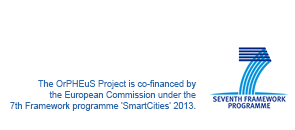Objective 4: Cooperative Control Strategies for cities' hybrid energy networks
Proposal of strategies for smart hybrid energy networks. Definition of cooperative control strategies for hybrid energy networks.
The overall aim whithin the tasks under Objective 4 is the definition of cooperative control strategies for hybrid energy networks. These strategies aim at an optimized approach for cooperation between various energy networks.
Their design is based on a comprehensive study of the specific use case environments and their extrapolation into a general Smart Cities strategy concept for planning and operational models, adaptable for a multitude of similar situations. In collaboration with the other tasks, various economic and social conditions will consider which can be tested in a simulation environment and discussed for realization under real-world demonstration conditions.
The following three control setups have been designed in order to represent and generalize the conditions present at the test sites in Skellefteå and Ulm:
For all three control setups the control algorithms for various use cases under different economic, social and technical conditions have been designed.The first two setups reflect the current local conditions in Skellefteå with certain modifications that allow achievements of the desired improvements. The last control setup comprises a set of prosumers with high penetration of renewable energy, corresponding to the Ulm’s demo sites.
Control set-up for the cooperative green supplier
The “Cooperative green supplier“ control setup considers the position of an energy provider aiming for efficient operation of a hybrid power-heating-network seen as a holistically managed system, including to cooperatively manage production units (like a wind farm, a CHP plant, some electric boilers), storage capacities (like some electric and thermal storage facilities), while considering the consumption demand profiles from the local electric and thermal grid. Depending on the available resources and the electricity price, the energy provider can buy or sell electric energy in a spot or day-ahead market. The customers of the energy provider are not actively involved in the control strategy actions. The control setup is driven by all possible use cases to invest the best possible interaction of all these components and their stakeholder goals. The specific market characteristic realized with this control setup is based on the traditional “Generation follows load” model.
Control set-up for the cooperative green supplier

Carbon-free heating setup
The “Carbon-free heating” control setup considers again an energy provider aiming for efficient operation of a hybrid power-heating-network; here the provider manages a CHP plant, some electric and oil boilers, some thermal storage facilities, and the local thermal grid. If necessary or convenient, the provider will be able to buy or sell electric energy in a spot or day-ahead market. The main concern is that the oil boilers are used to satisfy the heat demand peak, as it is the case in the Skellefteå demo site. The principal target of the control strategy is to reduce the oil consumption occurring during the periods of peak demand. The end-customers will play a crucial role by accepting to shift their heat loads, shaving the demand peak. Therefore the market specifics are here rather non-traditional, but typical for today’s smart grid considerations: loads are flexible sources for energy balancing approaches.
Carbon-free heating setup

Green community setup
The “Green Community“ control setup establishes a local energy balancing for active prosumers communities. All the prosumers have solar panels, thermal and electric storage facilities. Additionally some of them have heat pumps and gas boilers; others just heat pumps, while the last group also maintains gas and electric boilers. The prosumers can exchange their electric energy, buy or sell electric energy, and buy gas from a gas provider. The principal target of the control strategy is to minimize the total amount of energy (gas and electricity) bought from the energy providers, and operate the community grid as sustainable as possible with local energy capacities. The market conditions asked for in this final setup are creative with aspect of hybrid grids, as here prosumers aim to create local community competing and/or cooperating with the grid operators for their benefits.
Green community setup



